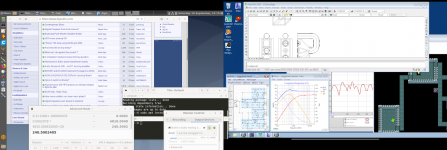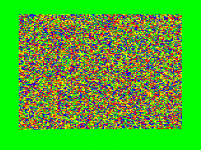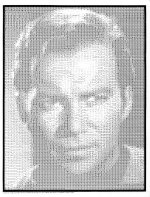Nigel,
I still run a lot of instruments made using Z80 (and one or two using the Z8 uC)
The biggest problem I have, is that I dont have a clue how to program them via the direct hex codes, or program the also ancient EEPROMs.
Converting to PIC seems like a complete redesign, hardware and software. It's a pain. Dealing with legacy DOS is also a pain. Everything has moved away from such methods of prototyping it would seem.
Programming using hex codes is a pain.
You could maybe disassemble it and turn into assembler.
That way changes would be much easier.
An Assembler would also output to Intel hex file which can be programmed into an EPROM.
Any other old folks out there that played shareware games like Captain Comic or Commander Keen?
Not those but I think larn on the Amiga is one of my all time favourites!
Our first "computer" game was a 1970's hanimex console very similar to this one File:Hanimex TVG 8610c (Pic 1).JPG - Wikimedia Commons the only difference being ours had a game called tank battle which was really cool (you could steer the shells around obstacles).
Later we had an atari 2600, and then A commodore 64. Best game on the 64 was impossible mission. I couldn't get through it but my little sister could!
Before the 64 we used to play "The Minitaur's lair" on an apple II at lunch time at school. A text based adventure game.
The Amiga as I said my favourite was Larn. Also played hack. I spent quite a lot of time on might and Magic II as well.
When I got a PC, Tomb Raider, and car racing games were the norm. I still have my logitech force feedback steering wheel.
I virtually never play computer games any more though.
Tony.
Commodore 64C
Talking about the Commodore 64C, when boy I had the Zaxxon (A 3D airplane war), the classic Ms Pac Man and the Boulder Dash, in cassettes, and after, the Test Drive in two floppy 5¼ diskettes, one for the program, and other for the scenes. I remember that the police patrol make an infraction if you run quickly, but if you drive the car sufficiently fast, the patrol couldn't make it, a radar inside the car alerts about them. In one of the corners, the small icon of the 6 position gear. Great game, perhaps one of the bests I played.
Talking about the Commodore 64C, when boy I had the Zaxxon (A 3D airplane war), the classic Ms Pac Man and the Boulder Dash, in cassettes, and after, the Test Drive in two floppy 5¼ diskettes, one for the program, and other for the scenes. I remember that the police patrol make an infraction if you run quickly, but if you drive the car sufficiently fast, the patrol couldn't make it, a radar inside the car alerts about them. In one of the corners, the small icon of the 6 position gear. Great game, perhaps one of the bests I played.
I've never been into computers, as my schoolmates ( all) did. But I remember helping a mate to make some ( dirrrrty 😛😱) animations on his spectrum with the PEEK and POKE commands. After, we found a book about AD/DA and the complete circuit and I built it! It was a double sided PCB and luckily we found the IC in our town and I handmade the PCB with transfer pitches and lines and...it worked ( just made it to blink 8 LEDs, never went to end the project of a robot arm with 4 motors )I started off in 1980/81 as a student electronics engineer.
I went on a Government tops (training opportunities scheme) course doing industrial electronics. As part of the course we were introduced to a Z80 based system called a Micro-professor. You had to type in hex codes (no assembler on this one) and you could read switches or display on a multi 7 segment display. So I was introduced to the Z80 and its architecture pretty early on. So assembly language wasn't too big a step. I still remember some Z80 hex codes like 0x3E to load accumulator. 0xCD for call and 0xC9 for return etc etc
In my first job I was an electronics engineer but dabbled as much has I could in Z80 on a ZX81 computer. They took on another hardware engineer who did the ULA chip I mentioned earlier but they had no one to write the software for the personal computers. I said I fancied a go and they gave me the job. I stumbled my way through it to start with but within a few weeks I was getting much better. Later I had to get into the 6502 processor for the Commodore 64 etc.
I did a fair amount of PEEKing and POKEing back in my VIC-20 days! 😉PEEK and POKE commands.
PEEK was pretty harmless and simply allowed you to see what the current value of a memory cell was.
POKE was risky because it allowed you to change an existing value to something else. POKE the wrong memory cell and your screen could fill up with gibberish!
Attachments
In the early to mid 80s when I worked for Texas Instruments they were a sub contractor for IBM making PC motherboards and later AT motherboards. This was at the same facility which was their Industrial Controls division where I worked.
We had a local computer club at TI and when TI would scrap out inventory the club members could buy it.
Initially we were modifying Sinclair ZX80s.
When clone boards became available we all started building PCs and then ATs.
I also bought a "Floppy Disk Alignment Diskette" which allowed me to realign scrapped floppies.
Both of my kids ended up with their own computers playing the likes of Commander Keen, Jill of the jungle, Hunt the Wumpus (Basic), Lemmings, etc.
By the time I built AT clones, we had 10BASE5 coaxial Ethernet run through the house with three computers linked together. So when the kids friends came over they would play games against each other.
We had a local computer club at TI and when TI would scrap out inventory the club members could buy it.
Initially we were modifying Sinclair ZX80s.
When clone boards became available we all started building PCs and then ATs.
I also bought a "Floppy Disk Alignment Diskette" which allowed me to realign scrapped floppies.
Both of my kids ended up with their own computers playing the likes of Commander Keen, Jill of the jungle, Hunt the Wumpus (Basic), Lemmings, etc.
By the time I built AT clones, we had 10BASE5 coaxial Ethernet run through the house with three computers linked together. So when the kids friends came over they would play games against each other.
I still play NetHack. Even got my kids into it.Also played hack.
I can't remember how many levels I managed to get down in Hack, but I got frustrated with it cause I would always reach a point where I just got killed.
I think we had NetHack at Uni, was that the version where you had all the usual monsters but could also encounter other players as well?
The nice thing about hack (and larn) on the Amiga was it used the programable character set so each thing you encountered in the catacombs had a little image rather than just an ascii character.
I just did a search on larn and there is a website that has a web based emulation of Amiga Larn! Now I'm in trouble, I've spent too many nights till the wee hours playing larn in my youth. Play Larn Online - A classic DOS/Amiga/Unix Roguelike Video Game
Tony.
I think we had NetHack at Uni, was that the version where you had all the usual monsters but could also encounter other players as well?
The nice thing about hack (and larn) on the Amiga was it used the programable character set so each thing you encountered in the catacombs had a little image rather than just an ascii character.
I just did a search on larn and there is a website that has a web based emulation of Amiga Larn! Now I'm in trouble, I've spent too many nights till the wee hours playing larn in my youth. Play Larn Online - A classic DOS/Amiga/Unix Roguelike Video Game
Tony.
I redefined the character set on the 64 for a couple of less time critical games. I was able to define a set of playing cards using an array of character strings that included cursor movement codes.
In the early 1980's I was involved with personal computers.
The business I worked for made Teletext adaptors.
I wrote the Teletext software for Sinclair Spectrum, Commodore 64 and BBC micro.
The Spectrum was hardest as it only had a 32 column screen and Teletext is 40.
So I had to make a new character set with 8*6 bits and bodge the colour attributes memory to make it look OK.
The business I worked for made Teletext adaptors.
I wrote the Teletext software for Sinclair Spectrum, Commodore 64 and BBC micro.
The Spectrum was hardest as it only had a 32 column screen and Teletext is 40.
So I had to make a new character set with 8*6 bits and bodge the colour attributes memory to make it look OK.
On the Spectrum the on/off bits were bitmapped into 6K of memory.
The colour attributes were a separate memory and one attribute covered 8bits by 8bits area square.
The BBC micro was easiest as it had a Teletext/Prestel mode (mode 7 I think.)
I cant remember much about the Commodore but it was 35 years ago !
The colour attributes were a separate memory and one attribute covered 8bits by 8bits area square.
The BBC micro was easiest as it had a Teletext/Prestel mode (mode 7 I think.)
I cant remember much about the Commodore but it was 35 years ago !
Bringing back memories!! On the C64 the rom used to be mapped to RAM, and I found where all of the error messages were stored and rewrote a few of them. The only one I can remember though was I changed syntax error to stupid error....
On the programmable characters, we had a 1526 dot matrix printer which could not print graphics, so I wrote a program to convert a bit map to 8X8 pixel programmable characters and output them to the printer. It worked but I ended up with a tiny picture, I didn't go so far as to scale it. The fact that I made a printer that couldn't print pictures print a picture was satisfaction enough 🙂
Now I remember my dad had some pictures that were printed on mainframe line (or drum) printers. They were done by just printing ascii (actually probably EBCIDIC) characters, often overlapping. That was quite impressive, would have been in the mid 70's.
Tony.
On the programmable characters, we had a 1526 dot matrix printer which could not print graphics, so I wrote a program to convert a bit map to 8X8 pixel programmable characters and output them to the printer. It worked but I ended up with a tiny picture, I didn't go so far as to scale it. The fact that I made a printer that couldn't print pictures print a picture was satisfaction enough 🙂
Now I remember my dad had some pictures that were printed on mainframe line (or drum) printers. They were done by just printing ascii (actually probably EBCIDIC) characters, often overlapping. That was quite impressive, would have been in the mid 70's.
Tony.
I've recently started gaming a bit (after a quite long hiatus), replaying a bunch of classics like Quake II, Half-Life, Portal, etc. up to more modern titles such as DOOM (2016 version), Left 4 Dead 2, etc.
I don't spend hours and hours playing, but I do enjoy it. The graphics in games these days are ridiculously good.
All of this is running via Steam in Linux, so I can't relate at all to the Windows issues described earlier in the thread.
I don't spend hours and hours playing, but I do enjoy it. The graphics in games these days are ridiculously good.
All of this is running via Steam in Linux, so I can't relate at all to the Windows issues described earlier in the thread.
On the Spectrum the on/off bits were bitmapped into 6K of memory.
The colour attributes were a separate memory and one attribute covered 8bits by 8bits area square.
The BBC micro was easiest as it had a Teletext/Prestel mode (mode 7 I think.)
I cant remember much about the Commodore but it was 35 years ago !
Teletext was the shiz, many hours spent in my early tweens searching horoscopes and all sorts of nonsense.
My first home computer was a Spectrum ZX16, the one with 16
 colours, and external tape cassette player to load programs. The rubber buttons made typing painfully slow for writing programs out of mags from the era.
colours, and external tape cassette player to load programs. The rubber buttons made typing painfully slow for writing programs out of mags from the era. The BBC micro/Acorn Micro were awesome to learn on though. I remember playing Frontier (Elite) space exploration and trading game at about age 8, using a joystick my uncle made (who used to design bits for satellites)
Anything was better than those awful Amstrads
I still have my vista PC running g for playing cracked games like Portal, HL, HL2.
Portal cracks me up everytime.
"Emancipation grid" and other classic turns of phrase!
I bought GWbasic and typed out the speaker design program in David Weems book, to find that the GOTO went nowhere, then couldn't be arsed to fiddle with it, and just got out the calculator and note paper!
Last edited:
printing ascii
Attachments
I'd been suffering the dual booting blues since a long time ago, now I run windows in a virtual machine. With Linux using two screens I can run them side by side, overlap or any ratio in between. With multiple virtual desktops I can set up, say, 8 screens worth of configurations.All of this is running via Steam in Linux, so I can't relate at all to the Windows issues described earlier in the thread.
Before this I was fiddling more with Wine and Dosbox and specific ports of programs.. and dual booting because I still couldn't get some things to work smoothly.

Allen,
Yes, when there is an actual "need" for Windows, I simply run it in VirtualBox. In fact, my main workstation for work (employment) is a Windows 7 virtual machine that runs on my personal Linux workstation. On top of that, I have personal installations of XP, 7 and 10 in virtual machines that I can run if/when I need them. I rarely do. Like you, I did run a few things in WINE back in the day.
All the gaming runs natively in Linux. With Steam + Proton, virtually any game on Steam is now available. That's a lot of games. Running games in a Windows VM is not feasible, unless you are talking about Solitaire. 🙂
Yes, when there is an actual "need" for Windows, I simply run it in VirtualBox. In fact, my main workstation for work (employment) is a Windows 7 virtual machine that runs on my personal Linux workstation. On top of that, I have personal installations of XP, 7 and 10 in virtual machines that I can run if/when I need them. I rarely do. Like you, I did run a few things in WINE back in the day.
All the gaming runs natively in Linux. With Steam + Proton, virtually any game on Steam is now available. That's a lot of games. Running games in a Windows VM is not feasible, unless you are talking about Solitaire. 🙂
Last edited:
- Home
- Member Areas
- The Lounge
- Computer games

